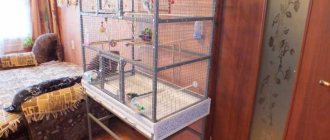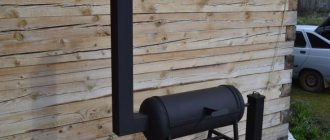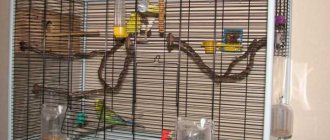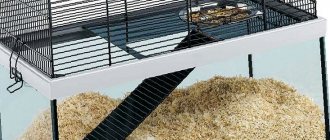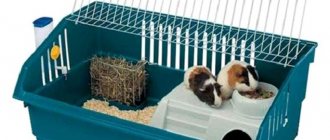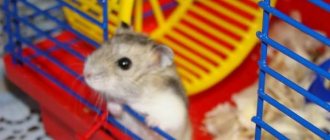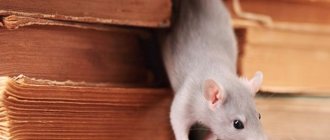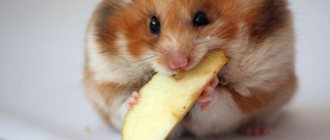When purchasing a budgerigar, the future owner must take care of all aspects of the pet’s comfortable stay in the house. First of all, this concerns the arrangement of its home - the cage where the bird will stay most of the time.
Today in pet stores you can buy a wide variety of models, of different shapes and made from a variety of materials. However, it is also important where in the house the cage will be located. It should be noted that not every room is well suited for this.
How to teach a parrot to talk?
The parrot should be placed on a hand or play stand, or left in a cage on a crossbar. After you manage to attract your pet’s attention, repeat the desired phrase 10-20 times in a row. These should be phrases that you use frequently in your daily life. Speak them clearly and emotionally.
Interesting materials:
Who listens to what music? Who lost weight on the buckwheat diet? Who Carols at Christmas? Who controls the execution of a court decision? Who controls the board of directors? Who's the best person to find truffles? Who is the financially responsible person in the organization? Who migrates to Russia? Who is Mister P? Who can be an official?
Where are the best places in the house for birds?
Before buying a budgie, you need to decide on the room where to put the cage with the parrot and where the budgie will live.
Here you should be guided by the fact that parrots are quite active and sociable birds that need constant interaction with their owner. In this regard, the most preferred room in the house may be the one where family members spend the most time.
This is, first of all, a living room . This is where all family members meet and spend time together. Thus, being in the living room, the feathered pet will not feel alone.
Does a parrot bother you at night?
Not really
Also, if for one reason or another it is not possible to place the cage in the living room, the bedroom would be a good place to place it in the house. As a rule, the owner spends quite a lot of time in the bedroom, and here, as a rule, there is a quiet and calm environment where the parrot will not be disturbed by external stimuli.
If the owner has a personal office in the house where he spends a lot of time working, then it is quite possible to place a cage with a feathered pet there.
In general, when choosing a room to place a cage there, the owner must take into account that this room must be fully suitable for the pet’s living conditions. There should be no drafts here, but it is desirable that normal air temperature and humidity be maintained.
Despite the fact that parrots need communication with people, birds do not tolerate excessive attention, especially from strangers. That is why you should choose a room where it is relatively quiet and calm.
In general, the best place for a cage in the house is somewhere where your parrot will feel comfortable.
About the incandescent lamp
Incandescent lamp in a parrot's cage It is worth starting with a preface about an ordinary incandescent lamp and an infrared lamp, one of which is recommended in many sources to be purchased and used if necessary.
An incandescent lamp for budgies is used as a heat source in some cases:
When using an incandescent lamp or an infrared lamp to heat birds, one half of the cage should be covered with thick dark fabric so that the parrot can go into the shade if necessary.
Internal filling: how to properly arrange a cage
The physical and psychological well-being of a feathered friend depends on how thoughtfully the owner has equipped his home. The larger the cell, the easier this process will go. With small dimensions, you will have to make do with the minimum of what the parrot needs, since the most important thing for him is space to move.
perch
The perch is one of the main items. For a bird it means the same thing as furniture such as a chair, sofa or armchair for a person. The bird will sit on the perch most of the time, so it should be comfortable.
The bird's fingers naturally wrap around the pole. For budgerigars, you need to install a perch with a diameter of 15 mm. The material of manufacture is wood. An incorrectly selected perch will lead to various diseases of the musculoskeletal system of the parrot.
The perch should not be sanded smooth. The bird should feel it and massage its paws.
Nest
A nesting house will only be needed by pairs of parrots during the period when they are planning to have offspring. The beginning of the mating season is indicated by the changed behavior of the birds. The males begin to actively court their female companion, offer the female food, and sort through the feathers.
The shape of the nesting house is important for the successful hatching of chicks. To make it convenient for the female to cope with her responsibilities, and for the chicks not to accidentally fall out of the nest, the length and width of the house should be 25x17 cm, and 25 cm high. The removable roof will ensure the quality of maintenance of the nest (arrangement, cleaning). The female will like it if there is a recess for laying in the thick bottom of the house. Sawdust mixed with chamomile protects chicks from being attacked by ticks. Sometimes a viewing window is made on the side of the wall for the chicks.
Parrots will breed only if they are provided with a nesting house. If the female throws out the sawdust, there is no need to insist. You can add them later when she sits on the eggs.
Drinking bowl
A necessary attribute for home improvement is a drinking bowl. The most basic is an open, stable bowl made of ceramic, metal or hard food-grade plastic. It is attached inside the cage to the bars or placed on the bottom. It is difficult to care for such a drinking bowl, since the parrot can turn it over, and the water is constantly contaminated.
Closed automatic drinkers are easy to use. They are equipped with a narrow spout that minimizes the entry of dust and dirt. The water stays fresh longer. But such a container also needs to be washed regularly with baking soda, outside and inside.
You can install two drinking bowls. From time to time pour natural fruit juice without sugar, diluted with water, into one of them. You can add 1-2 drops of lemon juice to ordinary water in order to replenish vitamin C reserves in the bird’s body. This is especially true in autumn and winter.
Feeder
A parrot should have 2-3 feeders in its cage for each type of food. The bird should always have grain. Fruits and vegetables are placed in a separate container as they are eaten. Another feeder is designed for mineral feed. The material from which it is made must be non-toxic and free from chips and nicks. If it is plastic, it is very hard, since parrots like to peck at everything. Feeders can be placed at the bottom of the cage, but it is better to attach them to the bars of the wall. There will be no need to disturb the bird once again to add grain.
Containers intended for vegetables and fruits must be washed at least once every two days. On the Internet you can find advice to parrot owners not to place a perch near the feeder. Supposedly this will lead to obesity. This advice is for those who do not want to feed birds in a balanced manner, introducing vegetables, herbs and fruits into the diet.
The parrot should be given the opportunity to stretch its wings, letting them fly around the apartment from time to time, and not be forced to suffer, making an attraction out of the process of getting food.
Clean feeders are the key to the health of birds. Therefore, they must be washed from time to time in hot water with the addition of baking soda and scalded with boiling water. You should not use detergents with fragrances to wash feeders.
Bathing suit
A bath is installed in the cage for the parrot. Special plastic bowls with high rounded sides are available for sale for this purpose. There are baths equipped with a dome to prevent water from splashing around the cage. The size must be selected individually.
The parrot especially needs bathing in hot weather. The purpose of water procedures is rather not hygienic, but to lubricate the plumage.
If you do not put a bathing area in hot weather, the parrot will use a drinking bowl for this purpose.
Sand
Coarse river sand is poured into a separate container. The bird needs it to grind food and replenish mineral deficiencies. Sand can be bought ready-made at a pet store. If you use river water, you must first wash it, separate it from dust and scald it with boiling water.
If you notice that your parrot is consuming too much sand, it is advisable to consult an ornithologist. Sometimes this indicates a violation of enzyme activity. In this case, veterinarians prescribe additional medications to improve digestion.
Birds not only eat sand, but also bathe in it. This should not be prevented. This way they get rid of possible parasites on their plumage and clean themselves of adhering dirt.
Sand placed along the edges of the cage simultaneously destroys unpleasant odors.
Change the sand to clean sand at least once a week. This is also done if it looks clean on the outside.
Lamp
Additional equipment is a lamp with ultraviolet radiation. This is necessary if the parrot is kept in an apartment, and it is not possible to take it outside or onto the balcony from time to time. In addition, such a lamp will help the bird calm down faster when moving from place to place.
If you equip the cage with a UV lamp, this will greatly facilitate the seasonal molting and hatching of chicks. The lamp is hung on the wall or ceiling above the cage.
The cord and socket should not be within the reach of the parrot. In summer, the cage is additionally illuminated for 12-14 hours. In winter there are several hours less.
A UV lamp is also useful if the room temperature drops below 18 ℃. The warmth from the lamp will create additional comfort in the cage when the chicks hatch.
Toys
Toys will help you set up your parrot's cage comfortably. It's rare that a parrot gets company for the whole day. Loneliness is destructive for this bird. For his normal mental state, various toys are used.
To maintain the psychological balance of a bird, it needs to be provided with toys: bells, rattles, a mirror. Items need to be arranged so that they do not clutter up the space, by allocating a play corner inside the cage for this purpose.
Toys can be different, just like the characters and tastes of birds. Therefore, you need to offer your pet another toy and watch his reaction. It happens that the sound of a bell or rattle is frightening, and the mirror is annoying. You should not insist, but offer other entertainment.
Stands (playgrounds)
Game stands for birds are designed not only for entertainment, but also for maintaining good physical shape and learning various tricks. The stands are equipped with ladders, swings, and exercise rings. Parrots like perches and bars placed in a chaotic manner.
It is advisable to locate game stands separately from the main housing. The parrot must clearly understand where each zone is and what it is intended for. This will teach him order. The pet will enjoy flying from one zone to another, which will become an element of training and education.
Conditions
The number of both feeders and toys directly depends on both the feathered pet and the configuration of the house. With the first, everything is quite simple - you will need two or three pieces, but the number and types of the second depend on the feathered pet. Separately, you should take care of the bathing suit - parrots like to keep themselves clean and periodically carry out bathing procedures. You should also purchase sources of calcium (regular chalk or eggshells) and add them to food or mineral supplements as needed.
Toys
Wavys are very active pets who love to spend their free time having fun and constantly demanding a portion of attention from the owner. At the same time, budgies, like any other living creatures, need to spend time alone. In this case, a variety of toys come to the rescue and need to be hung in the cage. But you need to know in moderation in everything, each pet has its own character, so the number and types of toys are selected individually for each wavy. He can interact with equal joy both with some expensive thing and with a small twig.
You can buy beads, hard shells or rings at the pet store. The latter can also be used as a replacement perch, helping to massage the paws. After your pet has already gotten used to its new home, you can slowly experiment with different toys. It will take some time for Wavy to get used to the new toy, so this is worth keeping in mind.
At what height is it better to attach the structure?
The height of the cage is no less important than the correct location in the house chosen for it.
Experts and experienced parrot owners recommend installing a pet house so that the bird is at eye level of the owner.
It has been noted that the height of the house directly affects the mood and formation of the pet’s character . So, if a budgie is too low, it will become depressed. If you place it too high, the parrot can feel dominated and become quite aggressive.
Today, quite tall and even multi-level cages are available for sale. Placing perches at different heights will allow the parrot to be where he feels comfortable.
How to determine a place in a room
Having decided on the room, you need to think about where in the room the cage will be located.
It is highly not recommended to install it in the center of the room. An open space around the cage is best; it can frighten the bird, leaving it constantly visible. It is best that one side of it faces the wall.
As for a specific location, in this case it is better to list those where it is not recommended to place the cage:
Near heating devices. As a rule, heating devices dry the air around them. In this regard, a bird whose cage is located near the battery may experience not only overheating, but also problems with the respiratory tract.- At the door. It is not recommended to place a cage near the door. The fact is that there is a constant movement of air through the doorway and drafts occur. There is a possibility that the bird may get sick.
- Near the workplace. It is not recommended to place a parrot house near the owner’s workplace. The fact is that in the process of life, the bird produces a lot of garbage, which easily spreads outside the cage itself.
- Near the air conditioners. Modern air conditioners and climate systems are convenient in the heat, but they pose a certain danger for parrots, which are extremely sensitive to drafts and sudden changes in air temperature.
It is also useful to read: What to feed a budgie
Criteria for choosing a cage for a budgie
Many owners choose a parrot cage based on its attractiveness, but this approach is wrong. A home for a feathered pet should be comfortable and safe. These are the main selection criteria.
Size and shape
To make it comfortable for a parrot to be in captivity, you need to choose a spacious cage with enough space for flying and stretching. The bird must be able to stretch its wings freely to flap them. When the bird sits on a perch, the tail should not rest against the bars.
Optimal cage sizes for budgies:
- Cage for permanent residence of one bird – 50x45x60 cm.
- For two parrots - 85x40x75 cm.
- Cage for transporting poultry (transport) – 40x30x40 cm.
- Quarantine cage – 70x55x65 cm.
- Cage-aviary for free flights – 205x75x160 cm.
The second selection criterion is the shape of the cell. Designs of different shapes are available for sale: rectangular, round, square. They can have a flat or convex roof.
Round-shaped structures look attractive, but in such houses parrots get lost in space and feel unprotected. Options with curved shapes and unusual roofs are also not recommended, as these structures may have dangerous bends that can injure the bird.
According to breeders, the most successful option is a spacious rectangular cage with a flat roof.
Material of manufacture
An important criterion when choosing a cage for a feathered friend is also the material from which the structure is made.
Types of cells from different materials and their features:
- Wooden structures are environmentally friendly and safe for birds. However, it is recommended to choose such cages only for temporary residence. This is due to the fact that wood absorbs moisture, and soon pathogenic bacteria that are dangerous to the health of the bird will form and multiply on the surfaces of the structure. In addition, parrots often gnaw wooden houses.
- Metal cages are the most practical models to use and can be combined with high-quality plastic. It is recommended to buy designs from trusted manufacturers who guarantee the safety of the product. Metal cages should be treated and powder coated or coated with non-toxic paint.
- Cages with copper and galvanized rods are not recommended for parrots, as these materials oxidize over time and release toxins that are dangerous to animals, causing not only serious health problems for the bird, but premature death.
So, a parrot cage should be spacious, safe and of high quality. The design should have doors that open to the side, from bottom to top or from top to bottom. The most convenient and safe option is to open to the side. The size of the door is based on the size of the bird. The owner's hand must also fit into the cage through this passage. For safety reasons, it is recommended to close the cage with a secure lock to prevent the bird from escaping.
Communication and training
Many people believe that large parrots, such as Macaws, Jacos, and Cockatoos, are “talking” birds, but this is not true. Wavys are also able to repeat words and insert them where needed, imitating an intelligent bird. It is very easy to teach a parrot to talk using some effective methods.
From birth, being among their own, the chicks imitate older parrots and learn to produce certain sound signals. When they are in captivity, they begin to repeat after those they see and hear, that is, to all family members.
4 essential principles for teaching a parrot to talk:
- Frequent classes. If the owner quickly decided to do this, then it is worth saying the same words regularly and every day. Since this activity is tiring, all family members can record individual words on a voice recorder and play it again.
- Insulation. This method is suitable for those who have not one, but several parrots. Because birds like to chirp among themselves, this can distract them from human speech, so isolate other parrots for a while.
- No anxiety. Before you start training with a bird, you need to understand whether it is alarmed. If everything is fine and she has adapted at home, then you can start.
- Prizes. Any pet can follow the owner's commands for encouragement. If the bird says the word, let it eat the prize. Just don’t overdo it so that your pet doesn’t lose interest in the lessons. Children will also enjoy this activity; they will be willing to watch them.
In which room is it better not to place a bird house?
At the end of the article, it is impossible not to mention the rooms in the house where it is undesirable to place a cage and explain the reasons for this.
- Kitchen. Many parrot owners place their pets' homes in the kitchen. However, this room is not the best for a bird’s comfortable stay. The fact is that food is prepared in the kitchen, and various types of household chemicals are also used. All this leads to an unfavorable indoor microclimate, which negatively affects the health of the feathered pet. In addition, many housewives periodically ventilate the kitchen, which increases the risk for the parrot to get sick due to a draft.
- Corridor . The corridor is a passage room where the owners do not spend much time. In addition, being near the front door is fraught with the risk of getting sick due to a draft.
- Children's room Being in a children's room is undesirable for a parrot for the reason that children are not always there, and in the absence of people, the bird may lack attention and communication.
It is also useful to read: Pros and cons of budgies
Where to put a parrot's cage?
Do you want to buy a parrot and have already decided on a specific type? So, it's time to buy a cage for your future pet. But first you need to decide on the optimal place for the cage in the apartment and prepare to meet your future feathered friend. Where to start? From choosing a location for the cage in the apartment. This location must meet a number of requirements.
One of the main points when choosing a cage location is sufficient, but not excessive, amount of sunlight. The cage should be placed in a place where sunlight illuminates it for 2-3 hours a day. You can place it on the side or opposite wall of the room from the window. In order for the bird to feel safe and not too exposed, one side of the cage should be close to the wall (the parrot should have a so-called “rest zone”).
Sunlight is essential for your parrot's health, but if you place the cage near a window, it will be difficult to avoid drafts. Draft is the main enemy of parrots. Don't forget about this when choosing the location of the cage. If there is a lack of light, you can use artificial lighting. If the sun shines too intensely, part of the cage will need to be covered with fabric so that the pet can hide in the shade if necessary. A window sill is absolutely not suitable for the location of the cage - the parrot may overheat or catch a cold.
The kitchen is not the place for a parrot's cage. Excessive evaporation, temperature changes, and frequent ventilation (drafts) can greatly harm the bird. In addition, a lot of dangers await your pet here: hot kettles, open pots, strong odors of cooking food, toxic emissions from Teflon cookware, etc. The corridor is also categorically not suitable - there is very little daylight, constant slamming of doors, drafts.
Parrots are social birds and need company. If there is a lack of communication, the pet will get bored, pluck its feathers, and other health problems will begin. Therefore, place the cage in a part of the apartment where life is constantly in full swing, but still in a not very restless place, so that the pet can sometimes have the opportunity to rest. It is best to place the cage in the living room or the room where the whole family usually gathers. But do not forget: the cage should not be in a draft, nor near heating devices or in close proximity to a TV, stereo system, or computer monitor (flashes of light and too loud sounds will annoy the bird).
Carbon monoxide and cigarette smoke should not enter the room with the pet. Also be careful when using various aerosols, for example, to kill household insects and other volatile substances with strong odors.
So, have you found a suitable location for the cage? Now you need to arm yourself with a tape measure and determine what maximum cell sizes are possible in the chosen location. These numbers will be your starting point when you choose a cage in the store. The larger the cage, the more comfortable your pet will be. However, there are minimum acceptable sizes of “apartments”: for medium-sized species it is 65x45x80 cm, for small ones - 45x45x70 cm. For such giants, such as, for example, large species of cockatoos, they no longer need cages, but mini-aviaries, and in an ordinary apartment such the design will take up a lot of space. You can read more about how to choose a cage for a parrot in this article.
Source
